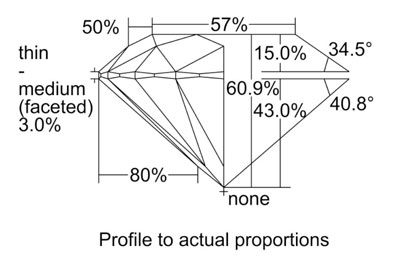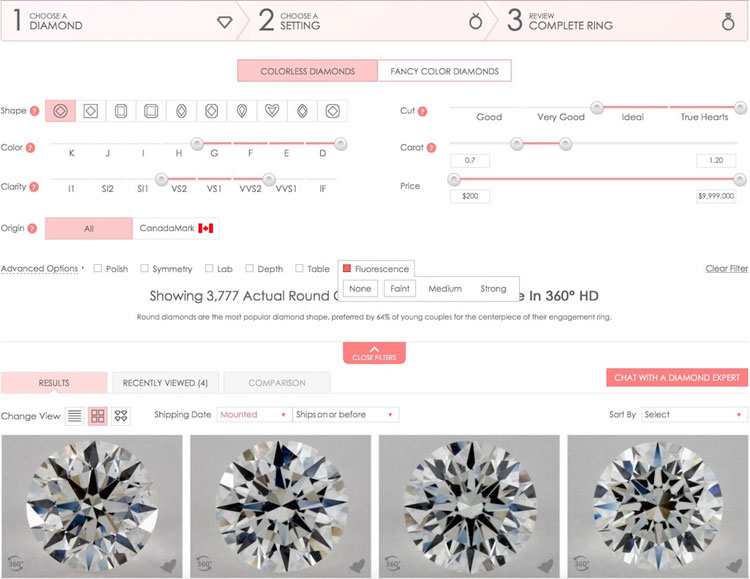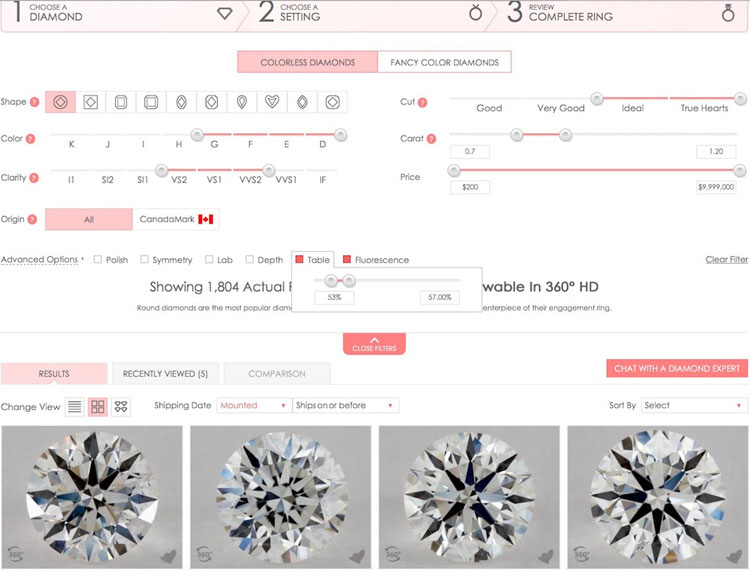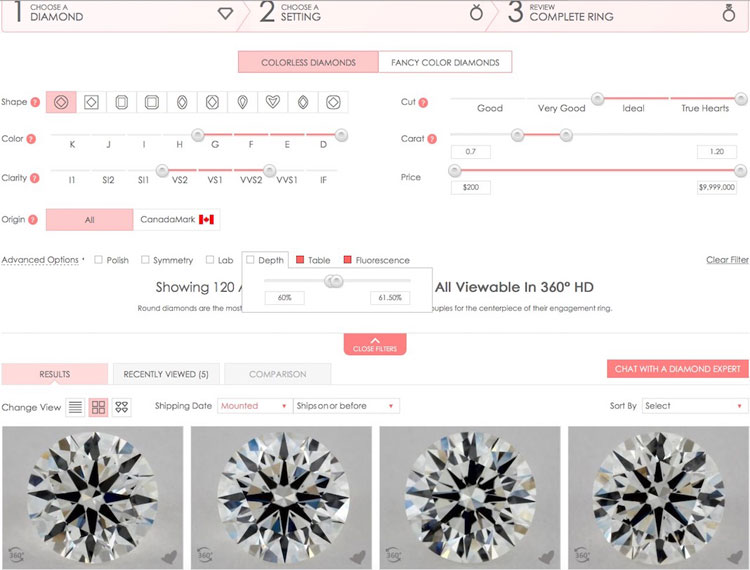If you need a little refresher on diamond cut, just take 5 minutes and go over that basic tutorial again. In that tutorial, I introduced the Tolkowsky Ideal-cut (TIC) set of proportions that Marcel Tolkowsky believed produced the optimum light performance for a round brilliant diamond. It turns out that there is actually a range of proportions that can be considered to have the top light performance characteristics identified by Tolkowsky.
Based on the TIC range of proportions, my recommended set of proportions for balanced light performance are:
Table Percentage: 55 – 57%
Total Depth:
– 60 – 61.5% (for girdle thickness between 2.5 – 3.5%)
– 61.5 – 62.5% (for girdle thickness between 3.5% – 4%)
Crown Angle (CA)/ Pavilion Angle (PA)
– For CA = 34°, PA = 41°
– For CA = 34.5°, PA = 40.6° – 40.8°
– For CA = 35°, PA = 40.6°
Star Length: 50 – 55%
Lower Girdle Length: 75 – 80%
Girdle Thickness: Thin to medium (2.5 – 3% preferred)
Note: For super-ideal diamonds such as Brian Gavin Diamond Signature Hearts and Arrows and Whiteflash A Cut Above, the steepest/deepest combination that does not compromise light performance is 34.8°/40.9°.
It is important for you to keep in mind that a diamond that seems perfect on paper is not guaranteed to be a good diamond. You cannot simply rely on the numbers alone so it’s important to always get an image of the diamond.
The reason for this is because the numbers on a lab report are the averages of the 8 sides of a diamond so if you want them to be meaningful, you have to also verify the optical symmetry. If a diamond with poor optical symmetry has a 40.9° pavilion angle, then most likely a few of the individual pavilion facets on the diamond are too deep and this will cause light leakage in the diamond.
How to Pick a Round Diamond
I’m going to show you how to use the search filters on James Allen to narrow down your options. You’ll need to click the button labeled ‘Advanced Options’ to have access to all the filters so look for it now so you can follow along.
Let’s start by putting on some basic filters.
At this stage, you should be able to narrow your selection to at least the following:
- Ideal/True Hearts
- Within 4 color grades
- Within 2 clarity grades
- Within 2 fluorescence grades
You can also put in your preferred price and carat range or you can do this after you’ve applied the advanced filters so you get an idea of how many diamonds you’re left with.
Now for more advanced filters.
Table Percentage
Set a filter for the table percentage to 55-57%. By doing this, you’ve reduced the number of diamonds to roughly the top 50% of all ideal-cut diamonds. If you find that you don’t have many choices, you can try to include 58% but I wouldn’t go any larger or the table reflection will become large. Small tables result in unnecessarily high crowns so what you’ll find is that not many diamonds are cut with a smaller than 53% table anyway.
Total Depth
The total depth filter will help you find diamonds that are most likely within my recommended crown/pavilion angles. By limiting the total depth to 60 – 61.5%, you further reduce the number of available options to the top 5% of all diamonds.
total depth = crown height + girdle thickness + pavilion depth
A higher crown generally implies that the crown angle is also steeper. Similarly, a deeper pavilion implies a steeper pavilion angle. It’s important to keep in mind that for balanced light performance, a steeper crown should be paired with a shallower pavilion and vice versa.
The ideal crown height is between 14-16% and the ideal pavilion depth is between 42.5-43.5%. So for a diamond with a thin to medium girdle (2.5 – 3%), a simple calculation results in a range of total depth to be:
min crown + max pavilion + min girdle = min total depth
14 + 43.5 + 2.5 = 60%
to
max crown + min pavilion + max girdle = max total depth
16 + 42.5 + 3 = 61.5%.
If you find you have too few choices, you can expand your search criteria to include medium or slightly thick girdles if all other proportions are within the recommended specs. Do this by increasing the total depth specification in increments of 0.5% up to a maximum of 62.5%. Just be aware that if the carat weight of the diamond is going into the girdle then it’s not going into making the diamond look bigger.
Note: Do not be alarmed when the reported total depth of a diamond does not equal to the sum of the reported crown height, girdle thickness, and pavilion depth. Remember that the reported girdle thickness is a description of the girdle at its valley positions. Do not be fooled into thinking that these are ‘warped diamonds’.
Polish and Symmetry
Symmetry is very important so you can go ahead and set it to excellent. If you are searching in the VS1 or higher clarity grades then I would recommend you also limit your search to diamonds with excellent polish. For VS2 diamonds and below, you can safely include diamonds that have very good polish grades as well.
Length-to-Width Ratio
After applying all the filters I’ve mentioned so far, you should have already been able to reduce the available options to a much more reasonable number of diamonds. If you still find that you are having trouble coming up with a short list, then you can consider adding the L/W ratio filter. James Allen doesn’t have this feature, but you can find this filter on Blue Nile and Enchanted Diamonds.
The length-to-width ratio is often missed as a tool to filtering round diamonds. I honestly don’t understand why it isn’t referred to more often because it’s obvious that the closer together these measurements are, the more round the diamond is. You will see later that being round is very important to diamond optics. On GIA certificates, two measurements of the diameter are given, one is for the maximum and the other is the minimum. It’s important to note that there is a 0.02mm margin of error in the measurement.
Choose a L/W ratio of 1.00. If you feel like you have too many choices then this is a good way to further narrow down your choices. In my test, adding this criterion reduced the number of diamonds to less than 3% of all diamonds.
Conclusion
If you follow my recommended proportions, you’ll be significantly increasing your chances of buying a diamond with decent light performance. But don’t stop here if you really want a top performing diamond because you’ll need to learn about optical symmetry which I’ll be discussing in the next tutorial.
I know it can be difficult for a beginner to come up with a shortlist of diamonds, so if you’re having trouble please feel free to contact me and I’ll do my best to guide you along.




